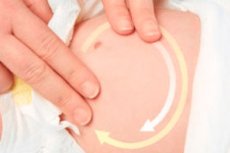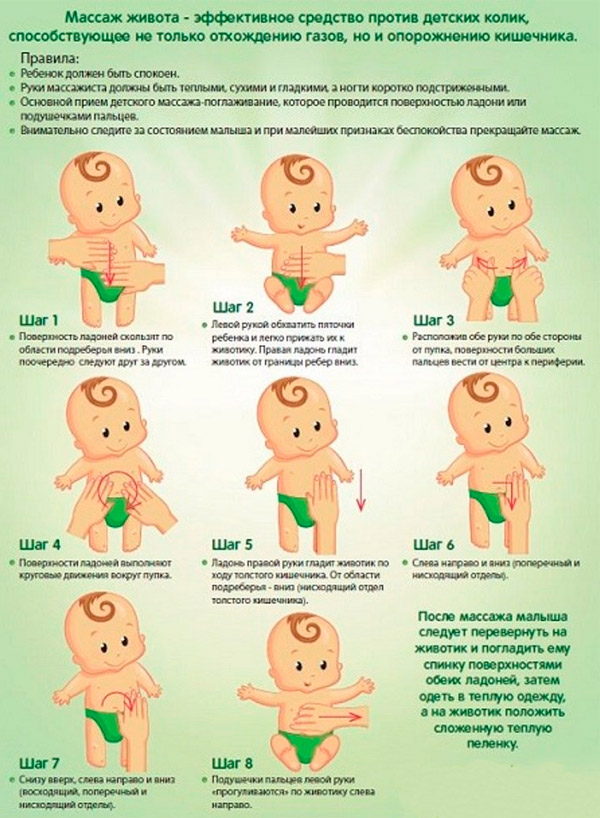Medical expert of the article
New publications
Massage for colic in newborns: how to do it correctly
Last reviewed: 04.07.2025

All iLive content is medically reviewed or fact checked to ensure as much factual accuracy as possible.
We have strict sourcing guidelines and only link to reputable media sites, academic research institutions and, whenever possible, medically peer reviewed studies. Note that the numbers in parentheses ([1], [2], etc.) are clickable links to these studies.
If you feel that any of our content is inaccurate, out-of-date, or otherwise questionable, please select it and press Ctrl + Enter.

Almost all newborns – about 90% to one degree or another suffer from intestinal colic. The reason for their occurrence is physiological in nature and is explained by the period of adaptation of the child's digestive tract to new conditions. There are many ways to alleviate the baby's condition, and one of such effective and affordable methods is considered to be massage for colic in newborns.
Colic in newborns is a painful spastic contraction of the intestinal muscles, which occurs due to the effect of increased gas formation on the walls of the organ. To put it simply, the baby forms a considerable number of gas bubbles inside the intestines, which press on its walls, causing spasms and pain. What is the task of performing a massage for colic in a newborn? It is necessary to speed up the removal of gases from the digestive system, gently stimulate peristalsis so that the child's intestines can cope with the problem on their own. When the gases come out, the baby will calm down - because there will be no more pain and spasms.
 [ 1 ]
[ 1 ]
Indications for the procedure
Colic is the result of the fact that the newborn's digestive system is not quite mature. The nervous and muscular regulatory mechanisms do not work well enough, the enzymatic activity is weak. Of course, all processes will return to normal after some time, but at first the newborn experiences colic, from which the child suffers.
Immediately after birth, the baby is offered a new type of nutrition - breast milk or formula (if there is no milk). The child's body needs time for the digestive processes to improve and the enzymes necessary for digestion to appear. During this period, colic may occur in newborns.
Colic in newborns occurs especially often when the baby is not attached to the breast correctly, when the baby swallows a large amount of air along with the milk. Colic can also occur if the baby is not at the breast for long and only manages to suck out the initial volume of milk, which is especially rich in carbohydrates - and carbohydrates, as is known, can cause increased gas formation.
The nutritional characteristics of the nursing mother also play a significant role. It is no secret that almost everything that the mother eats and drinks ends up in breast milk. Many products, getting into milk, can also cause colic in a newborn baby.
How to help a baby? First, it is necessary to exclude all possible causes of colic. Second, it is necessary to take other auxiliary measures - in particular, massage for colic in newborns will come to the rescue.
Preparation
In the room where the massage will be performed, comfortable conditions must be created - first of all, this concerns the temperature regime, so that the baby is neither cold nor hot. Before the massage, the baby's tummy should be warmed. This can be done with a warm diaper heated with an iron, or simply lay the baby on his or her stomach on the mother's or father's stomach - this way the heat will be distributed evenly, and the baby will calm down.
To perform a massage for colic, the massage therapist's hands must be warm - otherwise the baby will reflexively tense up and become frightened.
How to massage a newborn's tummy for colic? The procedure is carried out on the surface of the changing table, in the crib, or even in the arms of the parents. It is desirable that the baby is in a diaper or lies on a warm diaper - during the massage, not only gas can be released, but sometimes feces can be released. You should not use baby massage oil - it reduces the effectiveness of the massage for colic. It is better not to treat the skin with anything, or use a little baby powder.
Before you start a massage for colic in newborns, it is important to make sure that there is no air in the baby's stomach. To do this, the baby should be carried "in a column" and wait for burping. This measure is especially relevant if the child has recently eaten. Massage should not be performed immediately after feeding, as this can cause regurgitation or even vomiting in the baby. It is optimal to wait about 40-60 minutes after eating, and only then begin the procedure.
It is permissible to do massage for colic in newborns five to six times a day, including for prevention.
Technique massage for colic in a baby.
The entire procedure of massage for colic in newborns is carried out for no more than 6-7 minutes. As a rule, a longer massage brings discomfort to babies rather than relief.
The main exercises for the tummy are stroking movements, light pinching and gentle wave-like pressing. Any movements should be done clockwise - only in this direction can gases be removed from the intestines and peristalsis be facilitated.
How to massage for colic in newborns?
- We place our warmed hands, palms down, on the tummy and hold for a few seconds so that the baby gets used to the touch.
- Without removing your palms from your tummy, lightly press on it clockwise along the contours of your palms or in a circle. With each circle, you can slightly increase the pressure, avoiding the liver area (under the ribs on the right side).
- Keeping your hands on your tummy, we apply pressure alternately with one palm and then the other.
- We stroke the tummy with our palms, not forgetting the direction of the clock, and then from top to bottom of the tummy.
- We stroke the oblique muscles of the abdomen, from the sides to the center and from top to bottom.
- We stroke with our fingertips in a clock-like motion, as if describing a circle or square around the navel.
- We move our palms up and down, alternately with one palm and then the other.
- We describe circles on the tummy in the direction of the clock, first with one palm, and then with both at the same time.
- Next, bend the baby's knees and bring them close to the tummy, hold for half a minute. Usually at this time the baby passes gas.
- We stroke the legs and lightly stroke the tummy.

Gymnastics for colic in newborns
In addition to massage for colic in newborns, you can practice special gymnastic exercises that help improve the functioning of the digestive organs and strengthen muscles.
Gymnastics involves performing the following exercises with a newborn baby:
- We lay the baby with his back up, spread his legs so that the knees "look" to the sides, and the heels touch. We put our palm on the baby's feet - the baby pushes off at this moment. Such an exercise improves bowel function and helps to strengthen the muscles necessary for the baby to crawl.
- We hold the baby by the chest and head, the other hand is on the tummy. We imitate an airplane - we swing the baby as if we were flying.
- We place the baby with his tummy up. Holding the back and head, we slowly lift him up (as if sitting him down), and then lower him back to the starting position.
- Carefully roll the baby from his tummy to his back and back.
- We lay the child on his back, bend his knees. Holding the feet with one hand, we simultaneously spread the knees.
Contraindications to the procedure
You should not start a massage for colic in a newborn if there are the slightest symptoms of intestinal obstruction or strangulated hernia. You should be especially wary if the following signs appear:
- the abdomen is distended asymmetrically;
- under the palm of the hand, strong peristalsis is felt not throughout the entire abdomen, but only in one area;
- there is no stool, gases do not pass for a long time;
- the newborn baby is lethargic, the skin is pale;
- the baby's temperature rises;
- blood is released from the anus;
- a painful lump is found in the navel area;
- The newborn baby experiences severe, prolonged pain.
If there are such signs, it is better to show the child to a doctor, and without delay.
In addition, massage for colic in newborns should not be done if there are wounds, rashes, etc. on the skin of the tummy.
Consequences after the procedure
Any pediatrician will advise regularly giving your baby a massage for colic or to prevent it. If you do everything correctly, there will be no unpleasant consequences after the procedures, rather the opposite - the massage will make the baby feel better and strengthen the muscles of the baby's tummy.
Complications after the massage procedure are possible only if parents ignore contraindications and do the massage even when it is strictly prohibited. To prevent complications after the massage, you need to carefully read the list of contraindications and carefully examine the baby before the procedure. If everything is fine and the newborn has no contraindications, then you can start the massage, starting with light stroking movements.
Care after the procedure
At the end of the procedure, you should do a few calming strokes in a clockwise direction. After this, the newborn can be placed on his tummy, stroking his back, and let him rest. The diaper can be removed at this point - let the baby's skin rest too.
Doctors usually advise not to wait until the baby starts having colic – massage can be done for preventive purposes. Just a little time – and the baby will be calm. And along with colic, you can get rid of another problem – massage perfectly relieves constipation, strengthening the abdominal muscles and stimulating intestinal motility.
 [ 10 ]
[ 10 ]
Diet for colic in newborns
Almost everything that a mother eats ends up in breast milk. Therefore, it is very important, at least in the first four months, to carefully select foods for your diet. Of course, this is unlikely to help completely eliminate colic. But the baby's condition will normalize faster - especially if, along with establishing nutrition, the mother uses massage for colic in newborns.
Doctors especially do not recommend mothers to consume the following products:
- any dairy products;
- any beans;
- cabbage;
- raw fruits, raisins;
- sweet pastries, white bread.
By the way, it is advisable to exclude sweets completely during this period. Sugar is not only capable of provoking colic, but can also lead to the development of allergies and diathesis.
 [ 11 ]
[ 11 ]
Reviews
As can be judged from numerous reviews, a properly performed massage for colic in newborns really helps, if not eliminate, then significantly alleviate the problem. However, many mothers advise: do not forget about other ways to eliminate colic, for example, the use of carminatives. It is better to use them in combination with massage procedures. Both pharmaceutical drugs (Espumisan, Bobotik) and home remedies (infusion of dill or fennel seeds, chamomile tea) are suitable as such means.
It rarely happens that massage for colic in newborns does not bring any effect. But if this is the case, it is necessary to consult a pediatrician.

